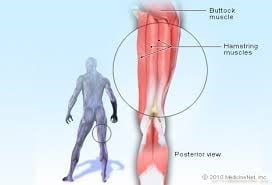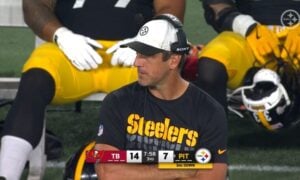In a preseason marked by a long list of healthy scratches, Steelers OLB Nick Herbig suited up for the second preseason game against the Tampa Bay Buccaneers. He logged only three snaps before he was sidelined for the night with a hamstring injury.
Herbig got off to a great start. On his first defensive play, a 3rd and 15, Herbig had Tampa Bay quarterback Teddy Bridgewater on the run. A seven yard pass was not enough for a first down and Tampa Bay had to punt.
Herbig returned to the field for two more plays in the next series. This is likely the play where he pulled a muscle:
You can see Herbig pull up short towards the end of the play and then continue towards the sideline.
Herbig was reportedly in and out of the blue medical tent fairly quickly after an evaluation by Dr. James Bradley and was then ruled out for the remainder of the game. According to Steelers Senior Director of Communications Burt Lauten, it was a hamstring injury. Based on those who had a good view of the sideline, the injury did not seem serious, as he chatted with Coach Tomlin and teammate TJ Watt:
In his post game press conference, Tomlin did not mention Herbig when reviewing injuries sustained during the game. When asked specifically if Herbig was OK, he responded with a crisp “yes” without elaborating further. Speaking with the media on Monday, Tomlin once again did not have Herbig on his list of inured players.
With starting linebacker Alex Highsmith still sitting out with a groin injury, the team is now very thin at the position just a few weeks from the season opener. Losing Herbig at the same time could create a significant challenge for the defense. While hamstring injuries can sideline NFL players for four to six weeks, that may not be the case for Herbig.
(Disclaimer: I have not reviewed any medical reports for this player and the opinions offered are based on information available from the team and media.)
First, we need to start with the anatomy. The hamstring is actually 3 muscles, the semitendinosus, semimembranosus, and the biceps femoris:
They start at the bottom of the pelvis at a place called the ischial tuberosity. They cross the knee joint and end at the lower leg. Hamstring muscle fibers join with the tough, connective tissue of the hamstring tendons near the points where the tendons attach to bones. The hamstring-muscle group helps you extend your leg straight back and bend your knee.
Hamstring injuries occur most frequently in sports that require athletes to sprint with sudden starts and stops. From the AAOS: During sprinting, the hamstring muscles contract eccentrically as the back leg is straightened and the toes are used to push off and move forward. The hamstring muscles are not only lengthened at this point in the stride, but they are also loaded — with body weight as well as the force required for forward motion.
Like many injuries, hamstring strains are classified by grade. Some sports medicine doctors will define the grade clinically:
- Grade 1 – tightness in the posterior thigh, able to walk without a limp, but unable to run at full speed.
- Grade 2 – pain with activity and walking with a limp, pain with knee flexion as well.
- Grade 3 – Unable to bear weight on the injured leg with severe pain and weakness.
Grade 3 injuries can involve a full separation of the muscle from the pelvis, where the tendon can actually cause an avulsion of the pubic bone. This results in a “popping” sensation and a nasty-looking wad of muscle on the back of the thigh.
The simple depiction of hamstring-injury grades:
https://www.thornleighphysio.com.au/
It isn’t quite that simple. Some hamstring injuries involve pure muscle tears and others are due to tendon tears and how proximal or distal along the thigh is also a factor.
An MRI is probably the best way to define hamstring injuries, which are graded by the radiologist based on:
The muscles or tendons involved (semimembranosus, biceps femoris short, biceps femoris long head, semitendinosus).
The location of involvement for each muscle or tendon (muscle belly or muscle/tendon junction).
The cross-sectional percentage of involvement (0, 25, 50, 75, 100).
The amount of tendon or muscle retraction in centimeters.
Any signs of chronic muscle or tendon damage.
The overall length on the damage along the muscle.
TREATMENT
Treatment includes the traditional RICE (rest, ice, compression, and elevation). After the swelling decreases, sports massage and ultrasound therapy can be used as well as foam-roller exercises to promote myofascial release to the muscles. Once the acute phase is passed, stretching and strengthening exercises are done but only if pain free. Eventually, the player will progress to more dynamic and functional exercise and finally graduate to football-specific drills.
How long this process takes depends, of course, on the extent of the muscle and tendon damage sustained. Plasma-rich protein (PRP) injections are sometimes used for acute hamstring injuries to reduce recovery time.
MEDICAL DATA
A 12-year review of hamstring injuries in the NFL database from 2008-2020 was published in the Orthopaedic Journal of Sports Medicine. Here is what they found:
– 1,354 players sustained 2,101 hamstring injuries
– The mean duration on the injury report was 2.4 weeks, which included DNP, limited and full participation
– 33 percent of players suffered reinjury, with 27 percent of those in the same season
– There was no difference in return to play for players with or without reinjury
– Hamstring injuries were more common in defensive skill players (50.4 percent) than offensive skill players (37.7 percent)
Pittsburgh’s Dr. James Bradley looked at the correlation between MRI findings and return to play and found that select players with Grade 1 hamstring injuries could return to play in less than one week. “Rapid return to play (< 1 week) occurred with isolated long head of biceps femoris injures with < 50% of involvement and minimal perimuscular edema, correlating to grade I radiologic strain (MRI score < 10).”
WILL HERBIG MISS GAMES?
The coaches had already held Herbig out of the first preseason game and they did not hesitate to shut him down quickly in the second game as soon as there was a question of injury. It is very likely he will miss the third and final preseason game, particularly considering the short turn-around time.
By all reports, his hamstring injury sounds like a mild Grade 1 sprain. If that is the case, he should be ready for the trip to New York to face the Jets.
“Melanie H. Friedlander, M.D., F.A.C.S. is a doctor at Association of South Bay Surgeons in Torrance, California. Dr. Friedlander enjoys all aspects of general surgery, but her primary areas of focus are breast surgery and advanced laparoscopic surgery. She recently adopted an advanced, minimally invasive technique that reduces scar size in thyroid surgery. Dr. Friedlander is a member of the Society of American Gastrointestinal Endoscopic Surgeons (SAGES) and the Society of Laparoscopic Surgeons. She developed and published many scientific studies in highly esteemed medical journals.”











